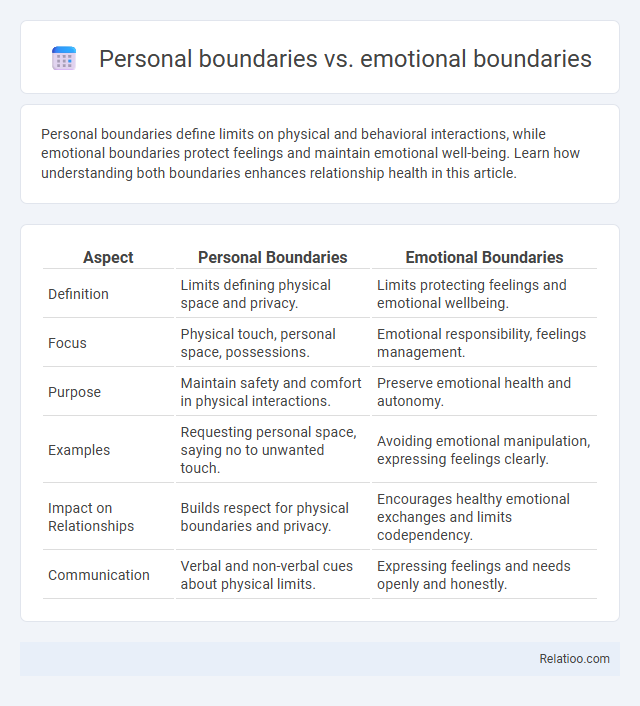Personal boundaries define limits on physical and behavioral interactions, while emotional boundaries protect feelings and maintain emotional well-being. Learn how understanding both boundaries enhances relationship health in this article.
Table of Comparison
| Aspect | Personal Boundaries | Emotional Boundaries |
|---|---|---|
| Definition | Limits defining physical space and privacy. | Limits protecting feelings and emotional wellbeing. |
| Focus | Physical touch, personal space, possessions. | Emotional responsibility, feelings management. |
| Purpose | Maintain safety and comfort in physical interactions. | Preserve emotional health and autonomy. |
| Examples | Requesting personal space, saying no to unwanted touch. | Avoiding emotional manipulation, expressing feelings clearly. |
| Impact on Relationships | Builds respect for physical boundaries and privacy. | Encourages healthy emotional exchanges and limits codependency. |
| Communication | Verbal and non-verbal cues about physical limits. | Expressing feelings and needs openly and honestly. |
Understanding Personal Boundaries
Understanding personal boundaries is essential for maintaining your emotional well-being and establishing healthy relationships. Personal boundaries define your limits regarding physical space, emotional vulnerability, and social interactions, guiding how others can treat you respectfully. Distinguishing these from emotional boundaries, which protect your feelings from manipulation or over-involvement, ensures you can safeguard your mental health effectively.
Defining Emotional Boundaries
Defining emotional boundaries involves recognizing your own feelings and limits, ensuring you do not absorb or take responsibility for others' emotions. Personal boundaries relate to your overall space and rights, while protection aims to safeguard your mental and emotional well-being. By establishing clear emotional boundaries, you empower yourself to maintain healthy relationships and prevent emotional burnout.
Key Differences: Personal vs Emotional Boundaries
Personal boundaries define the limits of your physical space and behavior tolerance, while emotional boundaries regulate how much emotional energy you share and accept from others. Emotional boundaries protect your mental well-being by managing feelings of guilt, responsibility, and empathy, preventing emotional over-involvement. Understanding these distinctions helps you maintain balanced relationships without compromising your sense of self or emotional health.
Importance of Setting Boundaries
Setting personal boundaries is crucial for maintaining mental health, as it defines limits on acceptable behavior, ensuring respect and self-care. Emotional boundaries protect individuals from emotional manipulation and allow for healthy relationships by distinguishing between one's feelings and others'. Protection through boundaries safeguards personal well-being and autonomy, preventing burnout and fostering resilience.
Common Signs of Boundary Issues
Common signs of boundary issues include feeling consistently overwhelmed, experiencing frequent guilt when asserting yourself, and difficulty saying "no" to others. Your emotional boundaries may be blurred if you often absorb others' emotions, leading to emotional exhaustion or confusion about your own feelings. Protective boundaries are compromised when you neglect self-care or accept disrespect, highlighting the need to clearly define and maintain your personal limits.
Examples of Healthy Personal Boundaries
Healthy personal boundaries involve communicating your limits clearly, such as saying no to extra work when overwhelmed, which preserves your mental health. Emotional boundaries mean distinguishing your feelings from others', allowing you to support friends without absorbing their stress or guilt. Protection includes setting physical space, like asking for personal space during conversations, ensuring your safety and comfort in social interactions.
Examples of Healthy Emotional Boundaries
Healthy emotional boundaries protect your mental well-being by allowing you to express feelings without over-sharing or taking on others' emotions, such as politely declining to absorb a friend's stress. Personal boundaries often involve physical or time limits, like saying no to social events when you need rest, while protection emphasizes guarding against emotional harm or manipulation, exemplified by refusing to engage in guilt-driven conversations. Establishing clear emotional boundaries fosters respectful relationships and empowers you to maintain your emotional health.
Impacts of Weak Boundaries on Relationships
Weak personal, emotional, and protective boundaries can lead to blurred lines that cause misunderstandings and erode trust in your relationships. When boundaries are unclear, you may experience increased stress, resentment, and vulnerability to emotional manipulation or burnout. Establishing and maintaining strong boundaries is essential to safeguard your well-being and foster healthy, respectful connections with others.
Strategies to Strengthen Your Boundaries
Setting clear personal boundaries involves identifying your limits in relationships and communicating them assertively to maintain respect and autonomy. Emotional boundaries require recognizing your feelings as separate from others', allowing you to manage empathy without absorbing emotional burdens. Protection strategies include practicing self-care, using mindfulness to stay grounded in your needs, and seeking support when boundaries are challenged to reinforce your emotional and personal limits effectively.
Personal and Emotional Boundaries in Everyday Life
Personal boundaries define the physical and mental limits that people set to protect their well-being, while emotional boundaries regulate the extent to which others influence one's feelings and emotional state. Maintaining clear personal and emotional boundaries in everyday life prevents stress, resentment, and emotional exhaustion by ensuring respectful interactions and self-care. Understanding the differences between these boundaries helps individuals foster healthier relationships and safeguard their mental health effectively.

Infographic: Personal boundaries vs emotional boundaries
 relatioo.com
relatioo.com